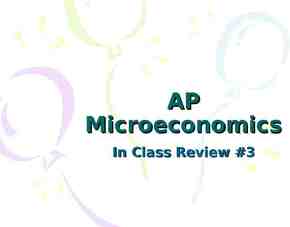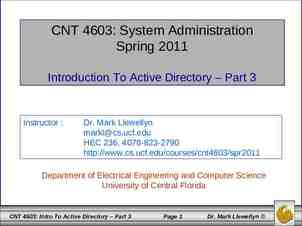CAQ WEBCAST PCAOB Insights on Smaller Firm Inspections The views
27 Slides826.00 KB
CAQ WEBCAST PCAOB Insights on Smaller Firm Inspections The views expressed by the presenters do not necessarily represent the views, positions, or opinions of the Center for Audit Quality or the presenters’ respective organizations. These materials, and the oral presentation accompanying them, are for educational purposes only and do not constitute accounting or legal advice or create an accountant-client or attorney-client relationship. Slide 1
Join the CAQ today! Visit www.thecaq.org/members or call 1-888-817-3277 Slide 2
CAQ Members-Only Web Site CAQ Inspection Readiness Resource Area Slide 3
Today’s Objectives Today’s program is designed to help you better understand: The basis used to develop the PCAOB’s 4010 report of domestic triennially inspected firms The 11 audit areas where significant or frequent auditing or quality control deficiencies were observed General responsibilities of the auditor Common inspection observations Slide 4
Today’s Objectives Mark West Regional Associate Director of Inspections PCAOB Joan Waggoner, CPA Partner in Charge of Quality Assurance Blackman Kallick Kurtis Wolff, CPA Principal in Charge of Audit and Assurance Reznick Group, P.C. ********** Cynthia M. Fornelli Moderator & Executive Director Center for Audit Quality Slide 5
Caveat The views expressed are my own views and do not necessarily reflect the views of the Board, individual Board members, or the staff of the PCAOB. 6
Overview Issued “Report on the PCAOB’s 2004, 2005 and 2006 Inspections of Domestic Triennially Inspected Firms” – October 22, 2007 7 Basis used for preparation of report Discussion of eleven audit areas where significant or frequent auditing or qualitycontrol deficiencies were observed General responsibilities of auditor Common inspection observations
Small Firm Statistics – Inspection Process Approximately 1000 domestic small firms are registered with the PCAOB Performed 497 inspections of domestic small firms between 2004 and 2006 8 Geographically dispersed Diverse in size, number of issuers and number of offices Approximately 62 percent of these firms had five or fewer issuer audit clients Only 10 percent of these firms had greater than 26 issuer audit clients Conducted engagement file reviews of portions of approximately 1600 issuer audits
Report Statistics There have been approximately 440 small firm reports issued as final to date related to the 2004 -2006 inspection period Approximately 248 reports (57 percent) identified at least one audit performance deficiency in one or more audits, as well as criticisms of, or concerns about potential defects in, the firm’s quality control system Rule 4010 report on small firms – 9 Describes deficiencies that the Board views as warranting emphasis in a general public report
Audit Areas Significant or frequent auditing or quality-control deficiencies were observed in 10 Revenue Related-Party Transactions Equity Transactions Business Combinations and Impairment of Assets Going-Concern Considerations Loans and Accounts Receivable (including allowance accounts) Service Organizations Use of Other Auditors Use of the Work of Specialists Independence Concurring Partner Review
Revenue General responsibilities of the auditor Common inspection observations 11 Perform substantive procedures to test existence, completeness, and valuation of revenue Review revenue contracts for terms and conditions that can impact revenue recognition Test whether revenue was recorded in the appropriate period Inappropriate use of testing A/R or inventory as a proxy for testing revenue recognition Inappropriate reliance on management representations without corroboration regarding appropriateness of revenue recognition Over-reliance on poorly designed analytical procedures Complex or specialized revenue-recognition principles not adequately addressed
Related Party Transactions General responsibilities of the auditor Common inspection observations 12 Identification of the existence of related parties Identification of material transactions with related parties Identification of material transactions that may be indicative of the existence of related parties Testing of the nature, economic substance, and business purpose of transactions with related parties not effective Address lack of disclosure of related party transactions
Equity Transactions General responsibilities of the auditor Common inspection observations 13 Evaluate compliance with applicable accounting principles in accounting for equity transactions, including adequacy of disclosures No evaluation of the reasonableness of fair value assigned to equity-based transactions for goods/services (employees or nonemployees) No testing of assumptions used to value options or warrants (e.g., volatility factor) Inappropriate reliance upon management’s decision to determine fair value based on other sources besides market value
Business Combinations and Impairment of Assets General responsibilities of the auditor Common inspection observations 14 Determine whether the transaction was accounted for in accordance with GAAP (e.g., valuation, purchase price allocation and disclosure) Inadequate testing of estimate of fair values assigned to assets acquired Inadequate testing of allocation of the purchase price to the assets acquired and liabilities assumed Inappropriate evaluation of client's accounting for and reporting of a business combination (e.g., common control merger, asset acquisition as business combination) Unaware of certain terms contained in the merger agreement (e.g., contingent considerations)
Business Combinations and Impairment of Assets General responsibilities of the auditor 15 Evaluate recoverability of intangible or other longlived assets in accordance with GAAP Common inspection observations Inappropriate reliance on management representations that asset values were not impaired Inadequate testing of underlying assumptions and data used to assess recoverability No evaluation of analysis prepared by management to support a recorded impairment charge
Going Concern Considerations General responsibilities of the auditor Common inspection observations 16 Evaluate whether there is a substantial doubt about the entity’s ability to continue as a going concern No going concern analysis performed despite warning signs, such as recurring losses, negative working capital, or accumulated capital deficits No evaluation of management’s plans to mitigate going concern conditions, or likelihood such plans could be implemented Address lack of disclosure of going concern conditions or management’s plan
Loans and Accounts Receivable (including allowance accounts) General responsibilities of the auditor Common inspection observations 17 Presumption that auditor will confirm accounts receivable unless certain conditions are present Evaluate reasonableness of the allowance for doubtful accounts or loan losses No consideration or documentation of rationale for not confirming A/R No or insufficient alternative procedures performed for confirmations not received or unresolved discrepancies from confirmation responses No testing of assumptions or underlying data used by management to develop the allowance for loan losses Inadequate testing of aging reports and collectibility of accounts receivable
Service Organizations General responsibilities of the auditor Common inspection observations 18 Consider effects of use of service organization on issuer’s internal controls Perform appropriate procedures to reduce assessed level of control risk below maximum Firm did not assess the operating effectiveness of user controls identified by the service auditor Firm did not consider whether the service auditor’s report provided sufficient evidence regarding the effectiveness of controls to support the assessed level of control risk If the SAS 70 report did not cover the entire period under audit, the Firm did not make inquiries regarding the possible changes in service organization controls
Use of Other Auditors General responsibilities of the auditor Common inspection observations 19 Determine whether firm can serve as principal auditor If taking responsibility for other auditor’s work (e.g., “outsourced” staff), determine involvement in planning, supervision, and review of work of other auditor Materiality of portion of financial statements audited by firm not sufficient to allow firm to report as principal auditor Insufficient planning, supervision, review and addressing of significant audit areas in audits where firm assumed complete responsibility for the work of other auditing firm and does not refer to the report of the other firm
Use of the Work of Specialists General responsibilities of the auditor Common inspection observations 20 Evaluate professional qualifications and relationship to the issuer Obtain understanding of methods and assumptions used and make appropriate tests of data Inadequate consideration of relationship between issuer and specialist which may impact the independence or objectivity of the specialist Inadequate testing of underlying assumptions and data used by the specialist
Independence – Prohibited Non-Audit Services Most common inspection observation noted on independence related to the preparation of financial statements and related footnotes The auditor is prohibited from providing bookkeeping and other services related to the accounting records or financial statements of the audit client, such as 21 Preparing the audit client's financial statements that are filed with the SEC or that form the basis of financial statements filed with the SEC Maintaining or preparing the audit client's accounting records Preparing or originating source data underlying the audit client's financial statements
Independence – Indemnification Firms entered into agreements which impaired their independence Accountant is not independent when he or she enters into an indemnity agreement with the issuer audit client that 22 Seeks to provide the accountant immunity from liability for his or her own negligent acts, whether of omission or commission, or Seeks to have the audit client release, indemnify or hold harmless the auditor from any liability and costs resulting from knowing misrepresentations by the audit client's management
Firm Independence Policies and Procedures and Independence Confirmation with Audit Committees Firms did not comply with quality control standards related to independence policies and procedures as required by PCAOB Rule 3400T(b) 23 Did not confirm independence of firm personnel Did not test accuracy and completeness of personal investment information Did not maintain current listing of issuer audit clients Did not offer independence training program Firms did not provide audit committee with written confirmation of its independence of the issuer within the meaning of the security laws
Concurring Partner Review Common inspection observations Scope of concurring partner review Timeliness of concurring partner review Review points are not addressed by the engagement team prior to release of the audit opinion Qualifications of concurring partner 24 No evidence that review was performed Reviewer does not have sufficient technical competence and/or experience
Questions & Summary Slide 25
Thank you for participating! Please visit us at www.theCAQ.org Slide 26
CAQ WEBCAST PCAOB Insights on Smaller Firm Inspections (end) Slide 27































